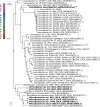Comparative genomics reveals a novel genetic organization of the sad cluster in the sulfonamide-degrader 'Candidatus Leucobacter sulfamidivorax' strain GP
- PMID: 31752666
- PMCID: PMC6868719
- DOI: 10.1186/s12864-019-6206-z
Comparative genomics reveals a novel genetic organization of the sad cluster in the sulfonamide-degrader 'Candidatus Leucobacter sulfamidivorax' strain GP
Abstract
Background: Microbial communities recurrently establish metabolic associations resulting in increased fitness and ability to perform complex tasks, such as xenobiotic degradation. In a previous study, we have described a sulfonamide-degrading consortium consisting of a novel low-abundant actinobacterium, named strain GP, and Achromobacter denitrificans PR1. However, we found that strain GP was unable to grow independently and could not be further purified.
Results: Previous studies suggested that strain GP might represent a new putative species within the Leucobacter genus (16S rRNA gene similarity < 97%). In this study, we found that average nucleotide identity (ANI) with other Leucobacter spp. ranged between 76.8 and 82.1%, further corroborating the affiliation of strain GP to a new provisional species. The average amino acid identity (AAI) and percentage of conserved genes (POCP) values were near the lower edge of the genus delimitation thresholds (65 and 55%, respectively). Phylogenetic analysis of core genes between strain GP and Leucobacter spp. corroborated these findings. Comparative genomic analysis indicates that strain GP may have lost genes related to tetrapyrrole biosynthesis and thiol transporters, both crucial for the correct assembly of cytochromes and aerobic growth. However, supplying exogenous heme and catalase was insufficient to abolish the dependent phenotype. The actinobacterium harbors at least two copies of a novel genetic element containing a sulfonamide monooxygenase (sadA) flanked by a single IS1380 family transposase. Additionally, two homologs of sadB (4-aminophenol monooxygenase) were identified in the metagenome-assembled draft genome of strain GP, but these were not located in the vicinity of sadA nor of mobile or integrative elements.
Conclusions: Comparative genomics of the genus Leucobacter suggested the absence of some genes encoding for important metabolic traits in strain GP. Nevertheless, although media and culture conditions were tailored to supply its potential metabolic needs, these conditions were insufficient to isolate the PR1-dependent actinobacterium further. This study gives important insights regarding strain GP metabolism; however, gene expression and functional studies are necessary to characterize and further isolate strain GP. Based on our data, we propose to classify strain GP in a provisional new species within the genus Leucobacter, 'Candidatus Leucobacter sulfamidivorax'.
Keywords: Bacterial consortium; Cryo-transmission electron microscopy; Metagenome-assembled genome; Phylogenetic analysis; Sulfonamides.
Conflict of interest statement
The authors declare that they have no competing interests.
Figures







Similar articles
-
Biodegradation of sulfamethoxazole by a bacterial consortium of Achromobacter denitrificans PR1 and Leucobacter sp. GP.Appl Microbiol Biotechnol. 2018 Dec;102(23):10299-10314. doi: 10.1007/s00253-018-9411-9. Epub 2018 Oct 8. Appl Microbiol Biotechnol. 2018. PMID: 30294753
-
Genomic Analysis of a Freshwater Actinobacterium, "Candidatus Limnosphaera aquatica" Strain IMCC26207, Isolated from Lake Soyang.J Microbiol Biotechnol. 2017 Apr 28;27(4):825-833. doi: 10.4014/jmb.1701.01047. J Microbiol Biotechnol. 2017. PMID: 28173694
-
Leucobacter weissii sp. nov., an isolate from activated sludge once described as first representative of the peptidoglycan variation B2δ, and emended description of the genus Leucobacter.Int J Syst Evol Microbiol. 2017 Dec;67(12):5244-5251. doi: 10.1099/ijsem.0.002454. Epub 2017 Oct 31. Int J Syst Evol Microbiol. 2017. PMID: 29087268
-
Leucobacter muris sp. nov., isolated from the nose of a laboratory mouse.Int J Syst Evol Microbiol. 2019 Jul;69(7):2095-2100. doi: 10.1099/ijsem.0.003446. Epub 2019 May 17. Int J Syst Evol Microbiol. 2019. PMID: 31099739
-
Leucobacter populi sp. nov. isolated from a symptomatic bark of Populus × euramericana canker.Int J Syst Evol Microbiol. 2016 Jun;66(6):2254-2258. doi: 10.1099/ijsem.0.001020. Epub 2016 Mar 11. Int J Syst Evol Microbiol. 2016. PMID: 26971343
Cited by
-
Cross-feeding and co-degradation within a bacterial consortium dominated by challenging-to-culture Leucobacter sp. HA-1 enhances sulfonamide degradation.Appl Environ Microbiol. 2025 Jul 23;91(7):e0059025. doi: 10.1128/aem.00590-25. Epub 2025 Jun 24. Appl Environ Microbiol. 2025. PMID: 40552827 Free PMC article.
-
Microbial degradation of contaminants of emerging concern: metabolic, genetic and omics insights for enhanced bioremediation.Front Bioeng Biotechnol. 2024 Sep 19;12:1470522. doi: 10.3389/fbioe.2024.1470522. eCollection 2024. Front Bioeng Biotechnol. 2024. PMID: 39364263 Free PMC article. Review.
-
Microbes as Resources to Remove PPCPs and Improve Water Quality.Microb Biotechnol. 2025 Jan;18(1):e70084. doi: 10.1111/1751-7915.70084. Microb Biotechnol. 2025. PMID: 39869488 Free PMC article. Review.
-
Antibiotrophy: Key Function for Antibiotic-Resistant Bacteria to Colonize Soils-Case of Sulfamethazine-Degrading Microbacterium sp. C448.Front Microbiol. 2021 Mar 26;12:643087. doi: 10.3389/fmicb.2021.643087. eCollection 2021. Front Microbiol. 2021. PMID: 33841365 Free PMC article.
-
Subsistence and complexity of antimicrobial resistance on a community-wide level.Environ Microbiol. 2020 Jul;22(7):2463-2468. doi: 10.1111/1462-2920.15018. Epub 2020 Apr 28. Environ Microbiol. 2020. PMID: 32286010 Free PMC article.
References
Publication types
MeSH terms
Substances
Grants and funding
LinkOut - more resources
Full Text Sources
Molecular Biology Databases
Miscellaneous

